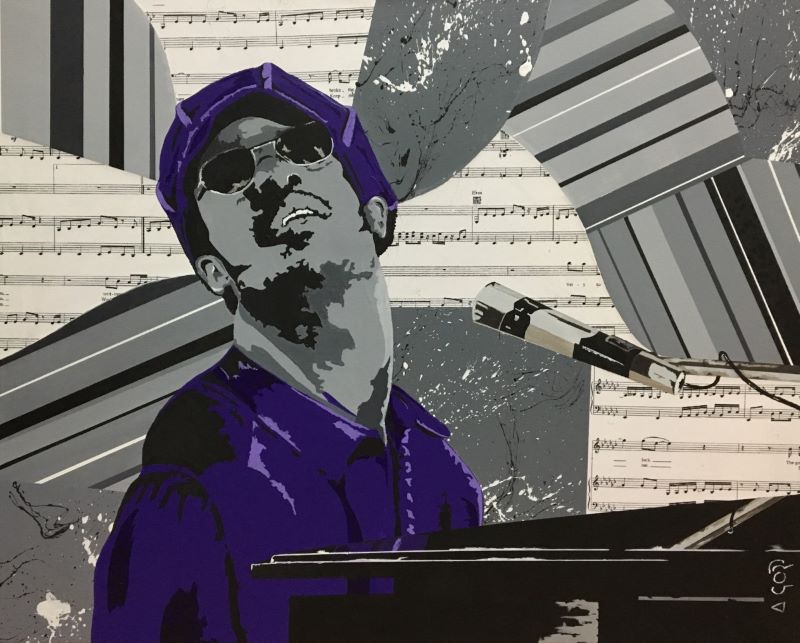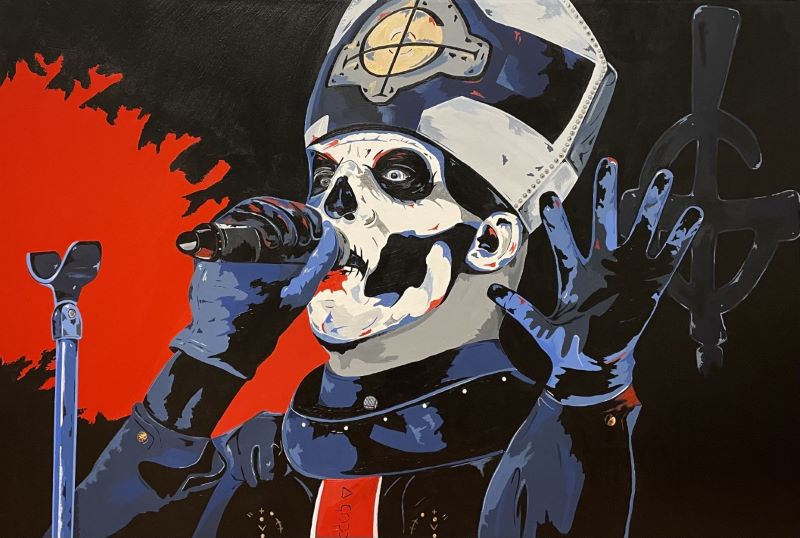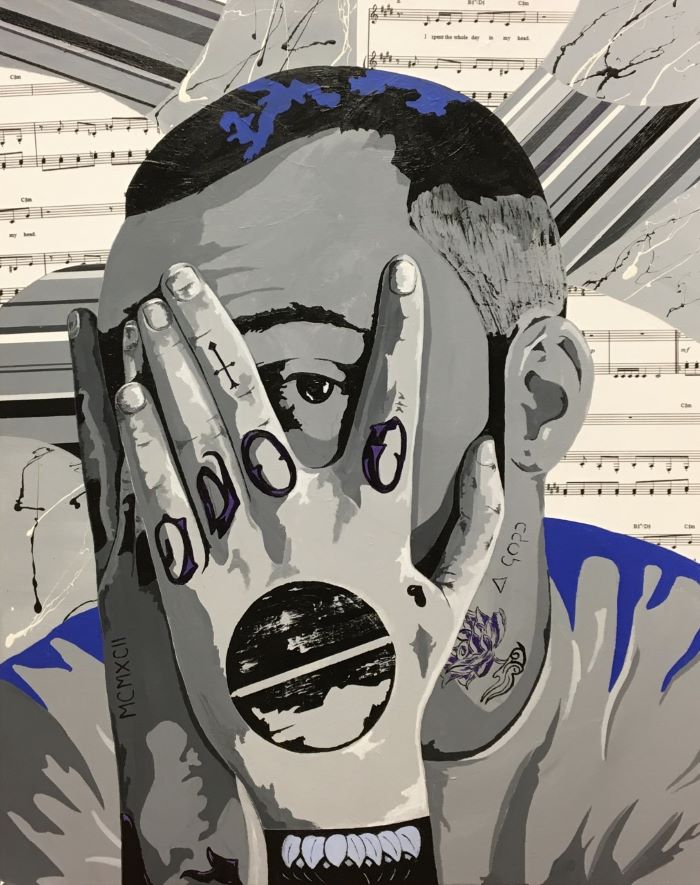
Al Gord was born and raised in Toronto, Canada, which is where he continues to reside today. The eldest of three, Al and his sisters were exposed to the arts, be it visiting local galleries and museums to attending live performances to being encouraged to create at home. As a child Al enjoyed drawing fantasy pictures of various creatures. In his teens he experimented with various subject matter and media including: watercolours, oils, and pastels; but he never found a style to call his own. After high school he put his interest aside, earning two university degrees, neither of them in the fine arts. After a long hiatus, he began painting as an adult, as a way to decompress from an intense career. During this period Al re-discovered his love of art.
Al, thank you for taking the time to share your story with us. This is the first time we have heard the term Industrial Pop Icon Artist. Can you tell us more about the style?
My pleasure and thank you for taking the time to interview me. The term is something I coined after discovering “Trash Polka” style tattoo work. When I first started painting, I played with different terms to describe my art. At one point I saw it as contemporary portraiture which then evolved to post-modern expressionism. As my style evolved to encompass more of an edgy street art feel, I felt that Industrial Pop Art best suits what I now do.
My art combines a variety of techniques, including abstract, portraiture, pop art, street art, graffiti, and expressionism, as well as using artist acrylic paint, acrylic latex and sheet music. Rather than create a traditional portrait my goal is to capture iconic moments in time, which brings out the rawness and energy of my subjects.

I Look Inside Myself and See My Heart is Black
Your work focusses on famous people. Where does your inspiration come from when you are painting and how do you choose your subject matter?
It is not as simple as having a list and moving down it, one person at a time. Rather, I am drawn to create a certain icon as silly as that may seem. That “connection” can be as simple as hearing a certain song repeatedly and in various settings over a short period – almost as if the universe is suggesting that said musician would make for a great piece.
My mood or things in my life can also influence who I paint. Sometimes it is as simple as I feel like listening to a certain musician and that individual becomes the focus. In other instances, I feel the need to change things up. If I have painted a few rock star pieces, I may move on to another music icon, from a different genre, whose work has been hugely influential. Then there are other people, not musicians, but individuals who have that rock star swagger, be it an actor, a character from a movie or television or an individual in another field, Einstein is a perfect example of this. Finally, when I really want to change things up I work on sensual pieces, with a rock music theme. These works allow me to show a different side of my art.
How do you feel when you are letting your emotions loose on the canvas?
Painting is incredibly cathartic for me, at least most of the time. There are moments where it can be frustrating. Trying to recreate the likeness of a famous person can be challenging and there is little room for error. However; the majority of the time painting is a blur and I get lost in my art. For me, painting is a full sensory, immersive experience; I listen to the music of the rock star I am painting or if I am painting someone who is not a musician, I listen to music that energizes me or captures the mood and energy of the piece.

The Little Tramp
Following up on the idea that certain pieces can be challenging, how do you stay motivated when working on a painting that is frustrating you?
That really is a great question! I view painting as any other endeavour – an opportunity for learning and growth. I can be very critical of my own work, sometimes to my own detriment. I have many interests and passions and so taking a break can be instrumental to the success of the piece. Like anything, it is important to have a sense of balance. While sometimes, it takes a little more motivation to create, usually a day or two away from the studio really helps me get back into the artistic mindset.
I am also not one to create in a linear fashion. I do not work on only one piece at a time. Sometimes I have up to four pieces, at various stages, on the go. If I am struggling with one, I work on a different painting. Finding success or a sense of ease with the new piece can help me when I return to the painting in which I was experiencing a challenge. Other times, I have a burst of inspiration for a new concept and so I temporarily “abandon” a piece. I have found this process to be beneficial for both my creativity and my overall sense of enjoyment.
Considering then that some pieces are harder to create than others, do you have a specific painting that you feel is your most rewarding or your favourite?
That is tough to answer! When I look back at my initial rock star painting, “The Wind Cries Jimi” a Jimi Hendrix tribute, it was special as it was the first time I felt as if I found my niche as an artist. For years I experimented with different artistic approaches and media, trying to find an approach that felt organic to me; one that kept my interest and passion for creating alive. While I have evolved as an artist, and my work has changed somewhat, the Hendrix piece was the catalyst for me finding my voice and signature style.
I find that I have new favourites all the time as I experiment and create works that “just feel right” to me. While there are many special pieces, I have learned not to become too emotionally attached to them, because it makes it harder to part with them.
As you mentioned a lot of your art highlights the rock music industry. I have heard you share that your work has a deeper meaning. Can you tell us about the underlying focus of your art?
I would hope that all my paintings have deeper meaning and impact. I know that for some, it may appear is if I am just another artist painting portraits, but nothing is further from the truth. Whatever the subject matter or discipline, art is very personal and meaningful to the artist. Each of my paintings have meaning, whether it is a tribute piece or a work meant to raise awareness of an important societal issue.
The backstory behinds each piece provides a glimpse into the icon. For some of these celebrities, other issues such as growing up in poverty, being seen as an outsider, or acting outside the norm. Because of the stardom, these figures have larger-than-life personas; however, at the end of the day, each of these icons are people, like you and I. They are not immune to the same issues and struggles we face, be it with family, health, personal struggles, etc. Mental health advocacy is something that is important to me. If my work helps raise awareness about this subject, an issue that impacts so many, celebrities included, than I feel as if I have made a difference with my art.

Twenty Twenty Twenty Four Hours to Go
Seeing as how you want to educate others through your art, what do you see as the role of the artist in society today?
That is an interesting question because there is the philanthropic and moral side of being an artist. Not to be forgotten is the role we play as cultural catalysts, people who tell stories, promote the arts and build appreciation of the changing landscape in the art world. I hope to inspire, raise awareness of issues and in some cases even provoke or push the boundaries of art – ultimately I want to make a positive difference.
Contained within all of this is the manner in which we impact the viewer and help them to form an emotional connection with the work. On a more intentional level it is about giving back to society, educating others and supporting important causes. I have created work for The Twitter Art Exhibit, which supports a new charity organization each year. It is a great way for new artists to make an immediate impact in the art world. I have also been approached by and worked with national not-for-profit organizations. Being able to donate some of my art and having it sell to raise money for charities is incredibly rewarding.
How do you navigate the professional art industry?
The first thing is to be patient. People hear about overnight successes and artists who make it huge, but being an artist is challenging. It is a tough industry and can be very hard to break into, especially gallery representation. Many artists I know create “on the side”, not as a side hustle or hobby, but because they need a full time job to pay the bills.
The second thing is to be true to one’s style and areas of interest. While certain styles of work may be more welcoming to the masses, the same styles can get stale and be overdone. I have to enjoy what I create and so I stay true to who I am as an artist and advise other artists to do the same.
Thirdly, I paint because I enjoy it. That is huge! If I am not enjoying what I do, then why invest so much time? While I may explore other styles and subject matter, out of interest, I create based on what drives me, rather than for someone else. It is how I maintain my passion. Finally, it is about having a great network of other artists. In my experience, the arts community has been amazing. I have been fortunate to connect with some incredible artists who have done quite well for themselves. They are giving with advice and their lived experience. When I meet artists new to the scene I try to pass along what I have learned to date, not that I am an expert by any means. Like any industry not everyone is willing to share their knowledge or support their “competition”, a term I use loosely, as there is opportunity for everyone.
I have been extremely fortunate in that I have met and continue to meet incredible artists, both from a talent perspective and from a social, interpersonal, and human connection standpoint. Artists should never underestimate the power of being there for other artists and helping other creatives.
Which art trends inspire your current work?
To be honest, art is so very personal that I focus on further developing my technique, my style, my voice as an artist. Trends come and go but a solid foundation and memorable style will resonate people. I enjoy modern art so I look to integrate various modern art elements and principles into my works. I love the art of both Stickman and Stacey Wells, two Canadian artists who focus primarily on the rock music industry. Their style are so uniquely different and I take inspiration from both, but I also want to carve out my own niche in the art world.
Taste wise, I am drawn to modern art and some photography, which is what I have hanging in my place. That is why my art really is a combination of various modern styles. I enjoy the challenge of creating iconic portraits – where my earlier pieces were a little more simplistic, I now look to add more details to the work. My work will never be confused with realism, nor do I want it to be – I want that pop art / street art feel, but with a twist; something that is different and unique.
In closing, if you could share one message with others what would it be?
Do what you love. To really make the most of the opportunities we have, we should always consider what makes us happy and do what we love. I have come to realize that the simple things in life are amazing, but one has to make a conscientious effort to step back and be in the moment. I got back into art due to a difficult time in my life. That time helped shape my art into what it is today. As a result, I have never been more passionate about my art then I am currently. If nothing else I always tell people to enjoy life, experience new things and do what makes them happy. Most importantly, create for the love of it. Everyone wants to be represented, to sell their work, and to be successful from an industry point of view. If that happens that is great; however, focus on the journey. Enjoy the process, the experience, the learning and growth and the people you meet. Never lose sight of why you first started creating – for the love of it.
Aside from his paintings, Al continues to be involved with various charities. He is in the early stages of doing collaborations with other artists. As well, Al is in the middle of working with a start-up group for a new art gallery along with a few other projects he is in talks over. His work can be seen and he can be reached through his website, Instagram and Facebook.








Leave a Reply